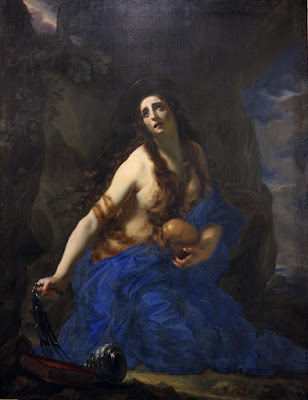 |
| attributed to Felice Ficherelli Portrait of a Girl ca. 1650 oil on copper Galleria degli Uffizi, Florence |
 |
| Domenico Fiasella (il Sarzana) Christ and the Woman of Samaria ca. 1640 oil on canvas Palazzo Bianco, Genoa |
 |
| Domenico Fiasella (il Sarzana) Death of Meleager (detail) ca. 1650 oil on canvas Accademia Ligustica di Belle Arti, Genoa |
 |
| Jacopo Vignali Balaam's Ass and the Angel ca. 1640-50 oil on canvas Palazzo Pretorio, Prato |
 |
| Simone Pignoni Penitent Magdalen ca. 1650 oil on canvas Basilica di Santa Maria Novella, Florence |
 |
| Francesco Gessi Holy Family ca. 1640 oil on canvas Collection of Franco Maria Ricci, Fontanellato |
 |
| Sassoferrato (Giovanni Battista Salvi) Holy Family ca. 1640-50 oil on canvas Musée Condé, Chantilly |
 |
| Sassoferrato (Giovanni Battista Salvi) Virgin in Prayer ca. 1640-50 oil on canvas Musée des Beaux-Arts de Strasbourg |
 |
| Giovanni Martinelli Mother and Child ca. 1640 oil on canvas Fondazione Cavallini Sgarbi, Ferrara |
 |
| Guido Reni Salome with the Head of John the Baptist ca. 1640-42 oil on canvas Art Institute of Chicago |
"Indeed, if we study the careers of the most important artists who followed Annibale Carracci from Bologna at the beginning of the century and introduced a new style of painting to Rome, a very consistent pattern emerges. The young painter would at first be found living quarters, in a monastery perhaps, by a cardinal who had once been papal legate in his native city. Through this benefactor he would meet some influential Bolognese prelate who would commission an altar painting for his titular church and decorations for his family palace – in which the artist would now be installed. The first would bring some measure of public recognition, and the second would introduce him to other potential patrons within the circle of the cardinal's friends. This was by far the most important step. For many years the newly arrived painter would work almost entirely for a limited group of clients, until at last a growing number of altarpieces had firmly established his reputation with a wider public and he had a sufficient income and prestige to set up on his own and accept commissions from a variety of sources. Once this had been achieved, he could view the death of his patron or a change in régime with some degree of equanimity."
– Francis Haskell, Patrons and Painters: a Study in the Relation between Italian Art and Society in the Age of the Baroque (Yale, 1980)
 |
| Guido Reni Blessed Soul ca. 1640-42 oil on canvas Pinacoteca Capitolina, Rome |
 |
| workshop of Guido Reni St Sebastian ca. 1650 oil on canvas Pinacoteca Comunale di Ravenna |
 |
| Giovanni Lanfranco Separation of St Peter and St Paul ca. 1641 oil on canvas Musée des Beaux-Arts de Carcassonne |
 |
| Anonymous Roman imitator of Nicolas Poussin Christ's Charge to Peter ca. 1640 oil on canvas Museo Diocesano, Lecce |
 |
| Jusepe de Ribera St Jerome ca. 1648 oil on canvas Fondazione Cavallini Sgarbi, Ferrara |